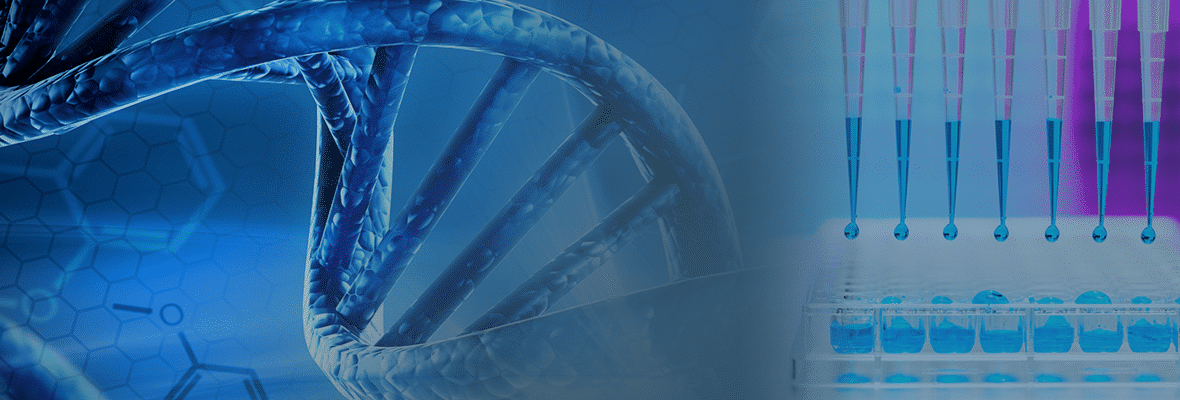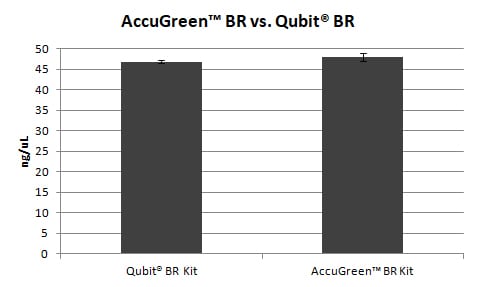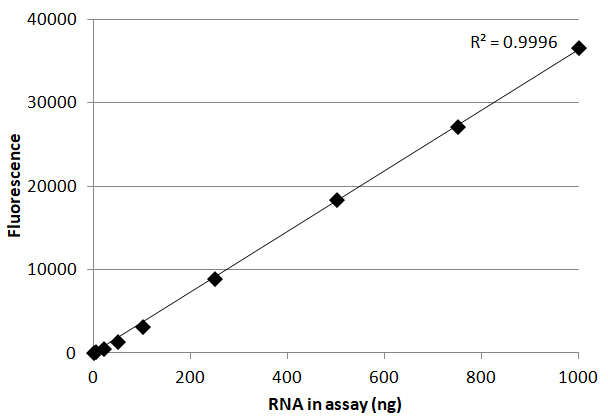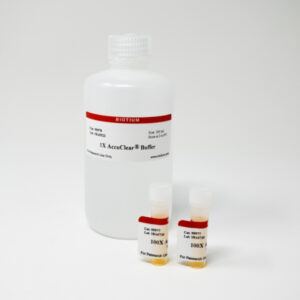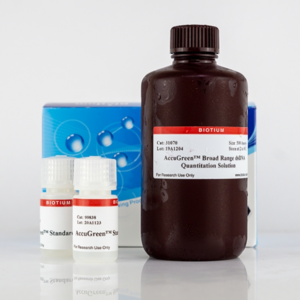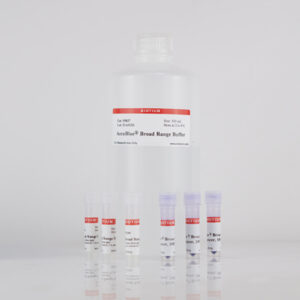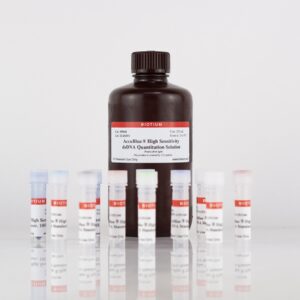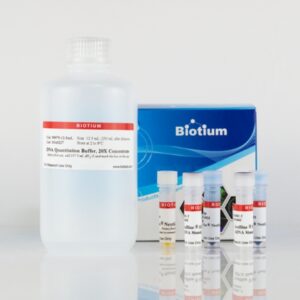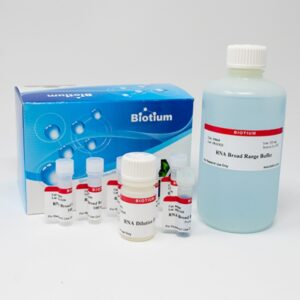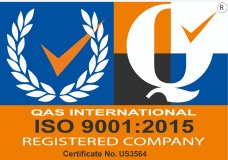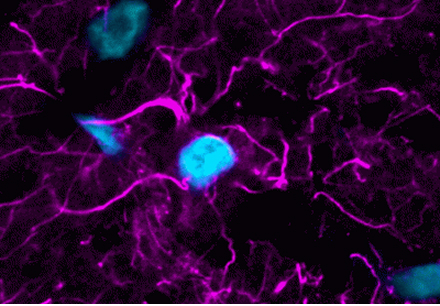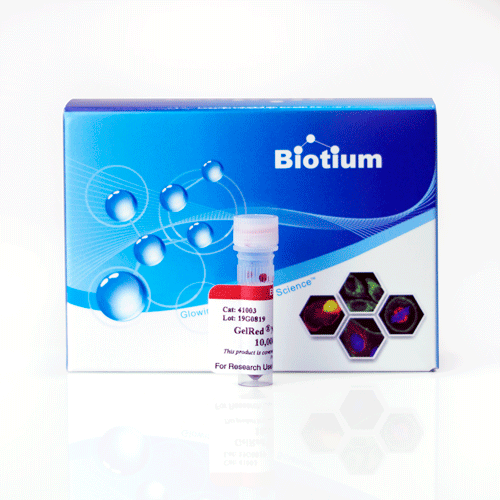Fluorescence-Based Nucleic Acid Quantitation
Fluorescence-based nucleic acid quantitation assays allow precise quantitation of purified dsDNA or RNA samples across a wide range of concentrations and a variety of fluorescence detection instruments.
Unlike absorbance-based nucleic acid quantitation, which cannot distinguish between DNA, RNA, and free nucleotides, fluorescent assays are highly selective for either dsDNA or RNA. Fluorescent assays also allow more sensitive detection of low concentrations of DNA or RNA, allowing you to preserve your precious samples.
Biotium offers dsDNA quantitation kits and solutions for different instruments and sample concentration ranges. We also offer an RNA quantitation kit with the widest linear range on the market and multi-instrument capability, making it the most convenient assay you will find.
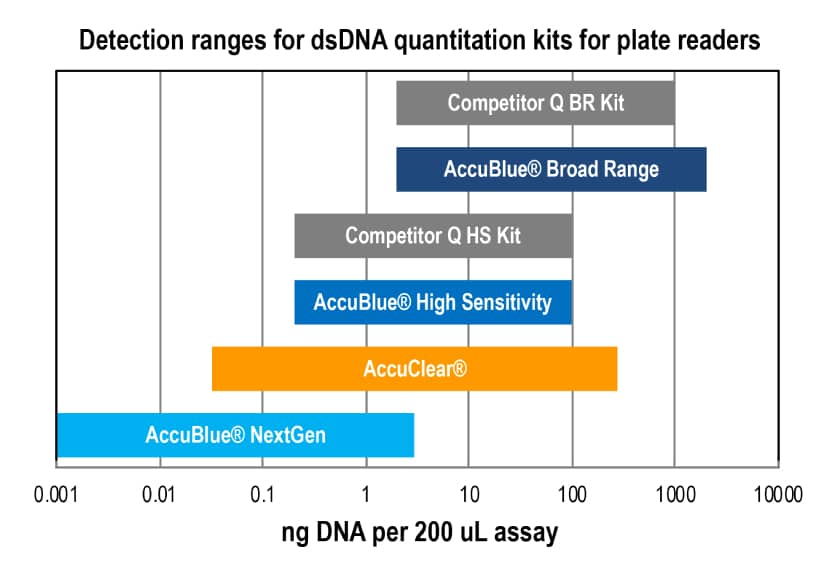
Microplate reader dsDNA assay features
- Quantitation of many samples and replicates at once, for better accuracy
- Highest sensitivity and adjustable excitation and emission settings
- AccuBlue® NextGen assay is the most sensitive DNA quantitation assay on the market (1 pg* DNA)
- AccuClear® assay is extremely versatile, with a very broad dynamic range, allowing quantitation of nearly any sample
Qubit® reader dsDNA assay features
- AccuGreen™ assay kits are designed for use in the pre-programmed dsDNA quantitation assays on the Qubit® reader
- AccuGreen™ assay kits are direct replacements for the Qubit® assay kits
- Significant cost savings when compared to the Qubit® kits
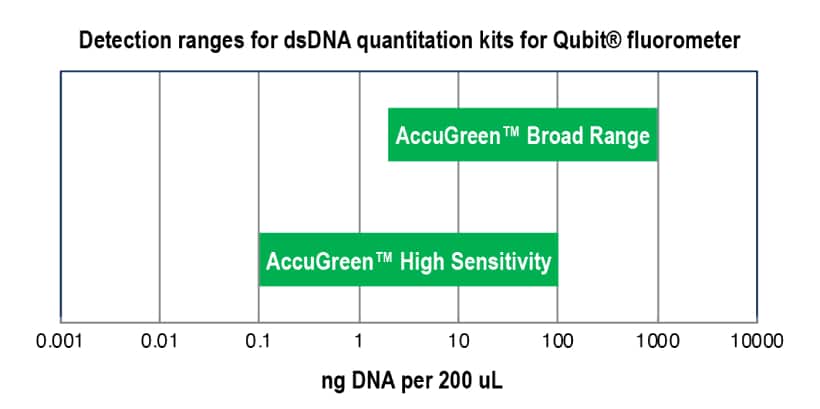
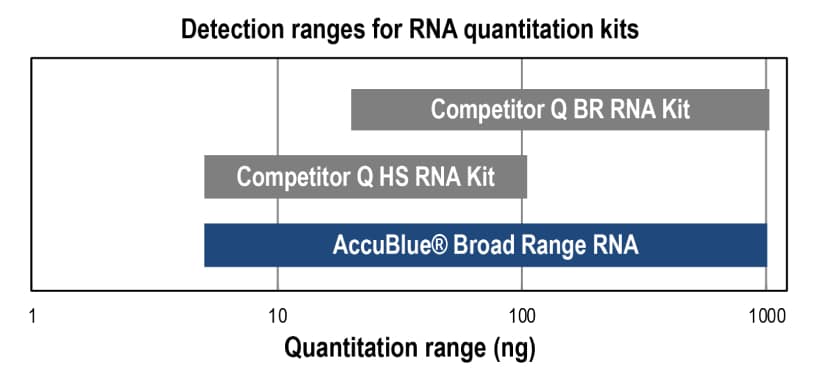
RNA assay features
- Linear range (5-1000 ng RNA) spans both Qubit® HS & BR ranges
- Highly selective for RNA over dsDNA
- Far-red fluorescence emission
- For fluorescence microplate reader or Qubit® fluorometer (RNA Broad Range program)
- Mammalian RNA standard to accurately quantify similar samples
All DNA & RNA Quantitation Kits
| Kit | DNA or RNA | Detection range (in assay)* | Dye Ex/Em (nm) | Suggested instrument | Features |
|---|---|---|---|---|---|
| AccuGreen™ High Sensitivity DNA | DNA | 0.1-100 ng | 502/523 | Qubit® fluorometer | Compare to the Qubit® dsDNA HS assay from Thermo Fisher |
| AccuGreen™ Broad Range DNA | DNA | 2-1000 ng | 500/530 | Qubit® fluorometer | Compare to the Qubit® dsDNA BR assay from Thermo Fisher Non-toxic & non-mutagentic DNA quantitation dye |
| AccuBlue® NextGen DNA | DNA | 1-3000 pg** | 468/507 | Fluorescence microplate reader | Most sensitive assay available for quantitation of precious or dilute samples Optimal for sensitive applications such as NGS or digital PCR |
| AccuClear® Ultra High Sensitivity DNA | DNA | 0.03-250 ng | 468/507 | Fluorescence microplate reader | Versatile kit with high sensitivity and wide linear range |
| AccuBlue® High Sensitivity DNA | DNA | 0.2-100 ng | 485/530 | Fluorescence microplate reader | Non-toxic & non-mutagentic DNA quantitation dye |
| AccuBlue® Broad Range DNA | DNA | 2-2000 ng | 350/460 | Fluorescence microplate reader | Broad linear range with blue fluorescence |
| AccuBlue® Broad Range RNA | RNA | 5-1000 ng | 650/670 | Fluorescence microplate reader or Qubit® fluorometer | The widest linear range of available RNA quantitation kits Exceptional accuracy, sensitivity, and high RNA selectivity |
** AccuBlue® NextGen limit of detection is in the range of 1 pg to 5 pg depending on instrument sensitivity
AccuBlue® NextGen DNA Quantitation
- Linear range: 1-3000 pg dsDNA
- Working solution stable for up to 6 months in the fridge
- Green fluorescence (Ex/Em: 460/507 nm)
- Perfect match for blue LED excitation sources
- For fluorescence microplate reader, compatible with Qubit®, QuantiFluor-P®, or Nanodrop® Spectrofluorometer
- Available with or without calf thymus dsDNA standard
Click here to download an App Note on using AccuBlue® NextGen on the BMG CLARIOStar® for extremely low amounts of DNA.
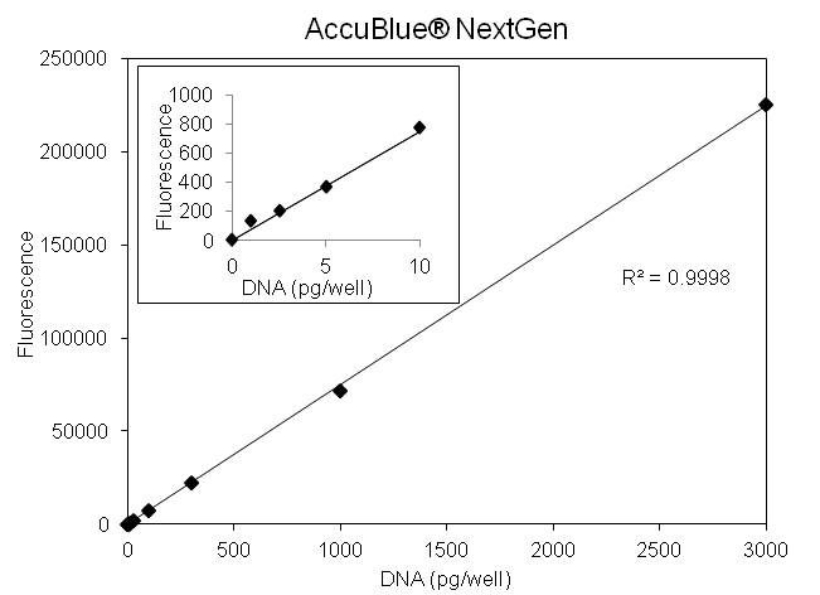
AccuBlue® NextGen Products
| Product | DNA Standards | Catalog No. | Size |
|---|---|---|---|
| AccuBlue® NextGen dsDNA Quantitation Kit | 10 ng/uL calf thymus dsDNA with instructions for preparing standard curve by dilution | 31060-T | Trial size (200 assays) |
| 31060 | 1000 assays | ||
| AccuBlue® NextGen dsDNA Quantitation Solution | None, for use with DNA standard of your choice | 31061-T | Trial size (200 assays) |
| 31061 | 1000 assays |
Accuclear® Ultra High Sensitivity DNA Quantitation
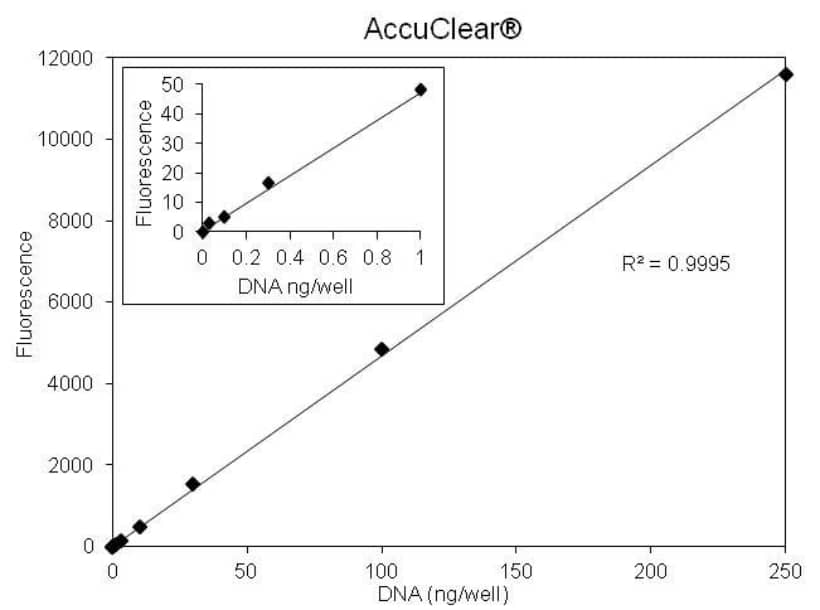
- Linear range: 0.03-250 ng dsDNA
- Very high sensitivity and dynamic range
- Green fluorescence (Ex/Em: 468/507 nm)
- Dye is a perfect match for blue LED excitation sources
- Designed for fluorescence microplate reader, spectrally compatible with Qubit®, QuantiFluor™-P, or Nanodrop® Spectrofluorometer
- Available with or without calf thymus DNA standards
AccuClear® Products
| Product | DNA Standards | Catalog No. | Size |
|---|---|---|---|
| AccuClear® Ultra High Sensitivity dsDNA Quantitation Kit with DNA Standards | 25 ng/uL calf thymus dsDNA with instructions for preparing standard curve by dilution | 31028-T | Trial size (200 assays) |
| Set of 7 prediluted calf thymus dsDNA standards | 31028 | 1000 assays | |
| 25 ng/uL calf thymus dsDNA with instructions for preparing standard curve by dilution | 31029 | 2000 assays | |
| AccuClear® Ultra High Sensitivity dsDNA Solution | None, for use with DNA standard of your choice | 31027-T | Trial size (200 assays) |
| 31027 | 1000 assays | ||
| AccuClear® dsDNA Standard, 25 ng/uL | Standalone DNA standard, 25 ng/uL | 31029C | 1 mL |
AccuBlue® High Sensitivity DNA Quantitation
- Linear range: 0.2-100 ng dsDNA
- Non-toxic, non-mutagenic dye for safer handling and easy disposal
- Green fluorescence (Ex/Em: 500/530 nm)
- Designed for fluorescence microplate reader, spectrally compatible with Qubit®, QuantiFluor-P®, or Nanodrop® Spectrofluorometer
- Available with or without calf thymus dsDNA standards
- Set of standards also available separately
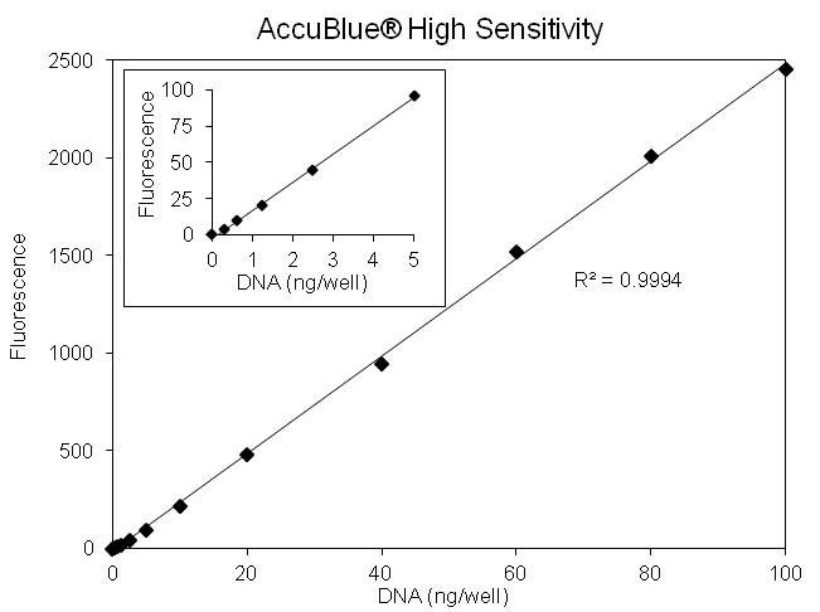
AccuBlue® High Sensitivity Products
| Product | DNA Standards | Catalog No. | Size |
|---|---|---|---|
| AccuBlue® High Sensitivity dsDNA Quantitation Kit with DNA Standards | 10 ng/uL calf thymus dsDNA with instructions for preparing standard curve by dilution | 31006-T | Trial size (200 assays) |
| Set of 8 prediluted calf thymus dsDNA standards | 31006 | 1000 assays | |
| AccuBlue® High Sensitivity dsDNA Solution | None, for use with DNA standard of your choice | 31008-T | Trial size (200 assays) |
| 31008 | 1000 assays | ||
| AccuBlue® High Sensitivity dsDNA Standards, Set of Eight | Stand-alone set of standards (0, 0.5, 1, 2, 4, 6, 8 and 10 ng/uL) | 31006C | 0.5 mL each |
AccuGreen™ DNA Quantitation Kits For Qubit®
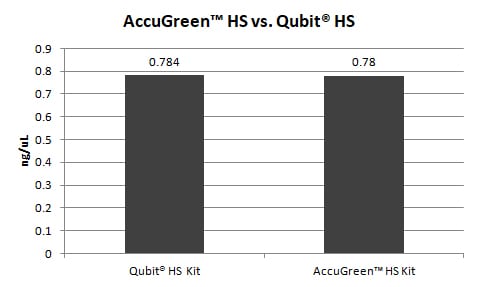
AccuGreen™ High Sensitivity
- Designed specifically to use with Thermo’s Qubit® fluorometer
- Linear range: 0.1-100 ng dsDNA
- Green fluorescence (Ex/Em: 502/523 nm)
- Serves as a direct replacement for Qubit® dsDNA HS Assay Kit for cost savings
AccuGreen™ Broad Range
- Designed specifically to use with Thermo’s Qubit® fluorometer
- Linear range: 2-1000 ng dsDNA
- Green fluorescence (Ex/Em: 500/530 nm)
- Serves as a direct replacement for Qubit® dsDNA BR Assay Kit for cost savings
AccuGreen™ Products
| Product | DNA Standards | Catalog No. | Size |
|---|---|---|---|
| AccuGreen™ High Sensitivity dsDNA Quantitation Kit (for Qubit®) | 0 & 10 ng/uL calf thymus dsDNA | 31066-T | Trial size (100 assays) |
| 31066 | 500 assays | ||
| AccuGreen™ High Sensitvity dsDNA Quantitation Solution (for Qubit®) | None, for use with DNA standard of your choice | 31068-T | Trial size (100 assays) |
| 31068 | 500 assays | ||
| AccuGreen™ Standard 2, 10 ng/uL | Standalone DNA standard, 10 ng/uL | 99820-T | 1 mL |
| AccuGreen™ Broad Range dsDNA Quantitation Kit (for Qubit®) | 0 & 100 ng/uL calf thymus dsDNA | 31069-T | Trial size (100 assays) |
| 31069 | 500 assays | ||
| AccuGreen™ Broad Range dsDNA Quantitation Solution (for Qubit®) | None, for use with DNA standard of your choice | 31070-T | Trial size (100 assays) |
| 31070 | 500 assays | ||
| AccuGreen™ Standard 2, 100 ng/uL | Standalone DNA standard, 100 ng/uL | 99838-T | 1 mL |
AccuBlue® Broad Range DNA Quantitation
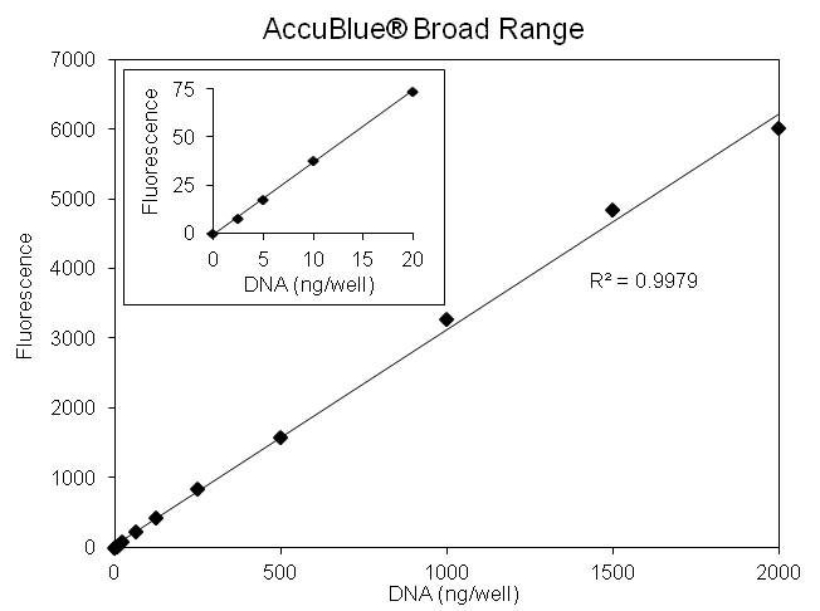
- Sensitive and selective detection of dsDNA samples
- Broad linear range: 2-2000 ng dsDNA
- Blue fluorescence emission (Ex/Em: 350/460 nm)
- Highly specific for dsDNA
- Engineered for use with fluorescence microplate readers
- Available with or without calf thymus dsDNA standards
- Trial size kit available (200 assays)
AccuBlue® Broad Range DNA Quantitation Products
| Product | DNA Standards | Catalog No. | Size |
|---|---|---|---|
| AccuBlue® Broad Range dsDNA Quantitation Kit with DNA Standards | 200 ng/uL calf thymus dsDNA with instructions for preparing standard curve by dilution | 31007-T | Trial size (200 assays) |
| Set of 9 prediluted calf thymus dsDNA standards | 31007 | 1500 assays | |
| AccuBlue® Broad Range dsDNA Solution | None, for use with DNA standard of your choice | 31009-T | Trial size (200 assays) |
| 31009 | 1500 assays | ||
| AccuBlue® Broad Range dsDNA Standards, Set of Nine | Stand-alone set of standards, 0, 2, 6.25, 12.5, 25, 50, 100, 150, and 200 ng/uL | 31007C | 0.5 mL each |
AccuBlue® RNA Quantitation Kit
AccuBlue® RNA Quantitation Kit Details
- Offers a broad linear range of 5-1000 ng RNA
- Far-red fluorescence emission (Ex/Em: 650/670 nm)
- Optimized for fluorescence microplate readers equipped for far-red fluorescence detection
- Optimized for the Qubit® 3 using the pre-programmed RNA BR program
- Kit includes a mammalian-derived total RNA standard
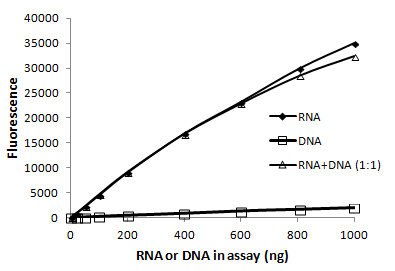
AccuBlue® RNA Quantitation Kit Advantages
- Selective: Can tolerate equivalent amounts of dsDNA (see Figure below)
- Convenient: Wide linear range spans Qubit®/Quant-iT™ HS and BR ranges
- Flexible: For fluorescence microplate reader or small fluorometer like Qubit®
- Accurate: The mammalian-derived total RNA standard provides the highest accuracy when quantifying samples from similar sources
AccuBlue® Broad Range RNA Quantitation Kits
| Product | Catalog No. | Size |
|---|---|---|
| AccuBlue® Broad Range RNA Quantitation Kit | 31073-T | Trial size (200 assays) |
| AccuBlue® Broad Range RNA Quantitation Kit | 31073 | 1000 assays |
